Electric guitars come in various shapes and sizes: from solid body guitars, semi-hollow body to hollow-body guitars. Even among the solid body guitars, there are hundreds of shapes and sizes to choose from. Guitars vary greatly in body shape, neck shape, and material.
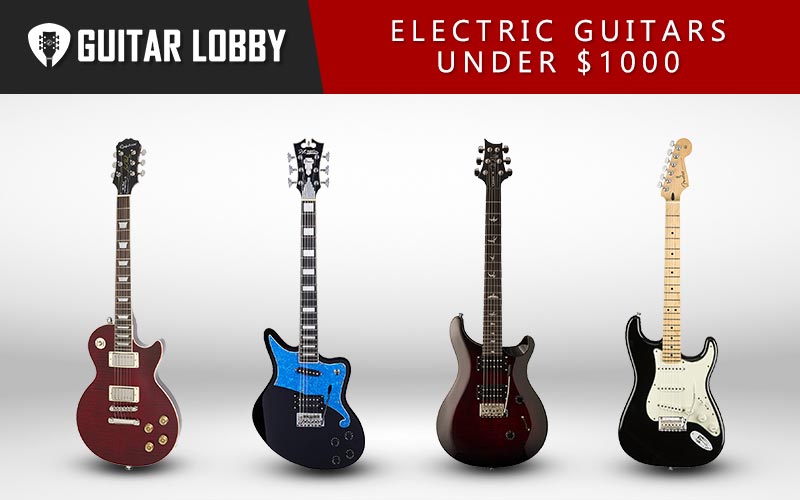
They also come in at a wide range of prices, and many great electric guitars can be bought for under $1000. And in this article, I want to focus on guitars that I think are the absolute best, including all-time classic models to up-and-coming game-changers.
I’ll start this article by reviewing my favorite guitars and helping you find the best electric guitar under 1000 dollars for your use cases, but if you’d want to learn more about electric guitars before jumping into reviews, we have an in-depth electric guitar information guide at the bottom of the page.
| Name of Product | Image of Product | Description | Price Range | Full Review |
|---|---|---|---|---|
| 1. Fender Player Stratocaster (Best Strat) | 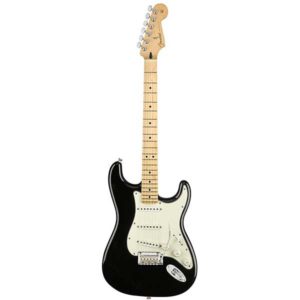 | Solid Body Pickups: SSS 22 frets | $700 | Read Full Review Below |
| 2. Fender Vintera ‘50s Telecaster (Best Tele) | 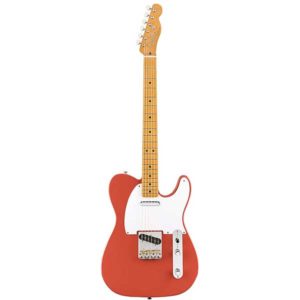 | Solid Body Pickups: SS 22 frets | $900 | Read Full Review Below |
| 3. Gibson Les Paul Studio Tribute 2019 (Best Single Cut) | 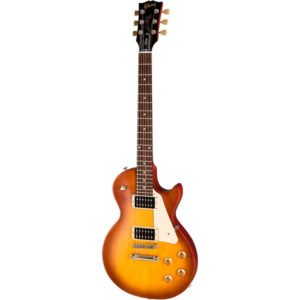 | Solid Body Pickups: HH 22 frets | $930 | Read Full Review Below |
| 4. PRS SE Custom 24 (Best Overall) | 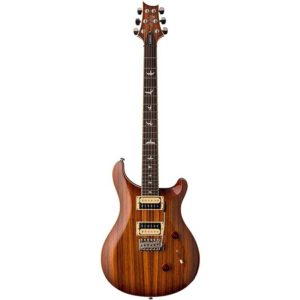 | Solid Body Pickups: HH 24 frets | $800 | Read Full Review Below |
| 5. Chapman ML1 Modern V2 Electric Guitar (Best Value) | 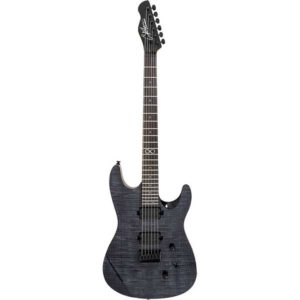 | Solid Body Pickups: HH 24 frets | $500 | Read Full Review Below |
| 6. Yamaha Revstar RS502T | 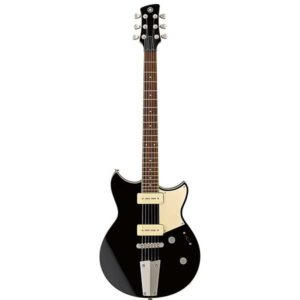 | Solid Body Pickups: SS 22 frets | $650 | Read Full Review Below |
| 7. Charvel Pro-Mod So-Cal Style 1 HH FR | 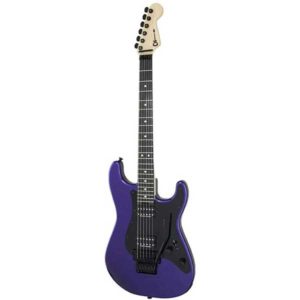 | Solid Body Pickups: HH 22 frets | $900 | Read Full Review Below |
| 8. Epiphone 1959 Les Paul Standard Outfit | 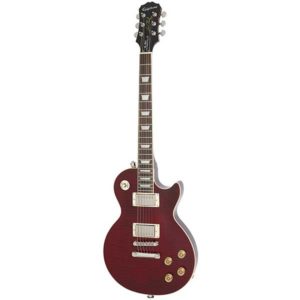 | Solid Body Pickups: HH 22 frets | $800 | Read Full Review Below |
| 9. Epiphone SG Standard ‘61 | 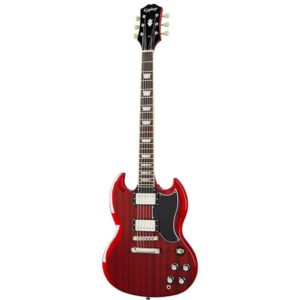 | Solid Body Pickups: HH 22 frets | $450 | Read Full Review Below |
| 10. Epiphone Sheraton-II Pro | 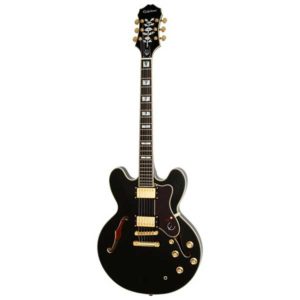 | Semi-Hollow Pickups: HH 22 frets | $700 | Read Full Review Below |
| 11. Ibanez Genesis Collection RG550 | 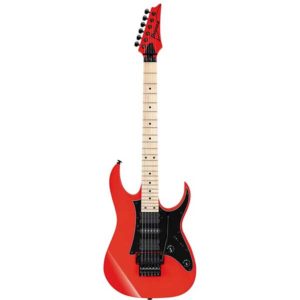 | Solid Body Pickups: HSH 24 frets | $1000 | Read Full Review Below |
| 12. D’angelico Premier Bedford (Editors Choice) | 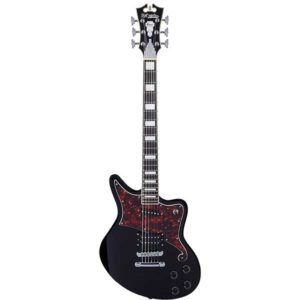 | Solid Body Pickups: HS 22 frets | $700 | Read Full Review Below |
| 13. ESP LTD EC-1000 | 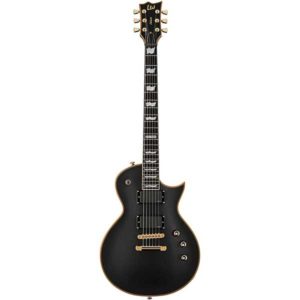 | Solid Body Pickups: HH 22 frets | $1000 | Read Full Review Below |
| 14. Sterling by Music Man MAJ100 | 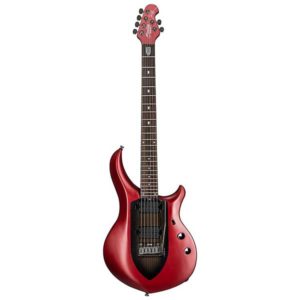 | Solid Body Pickups: HH 24 frets | $905 | Read Full Review Below |
| 15. Gretsch G5420T Electromatic Hollow Body | 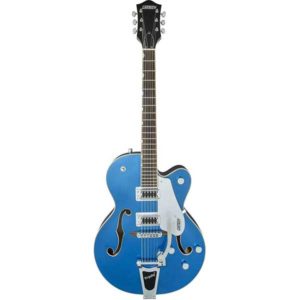 | Semi-Hollow Pickups: HH 22 frets | $800 | Read Full Review Below |
| 16. Jackson Rhoads JS32 | 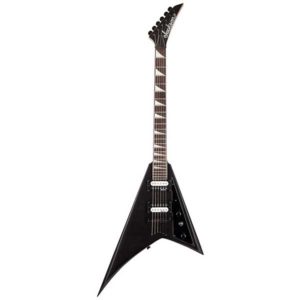 | Solid Body Pickups: HH 22 frets | $350 | Read Full Review Below |
| 17. Squier Bullet Stratocaster | 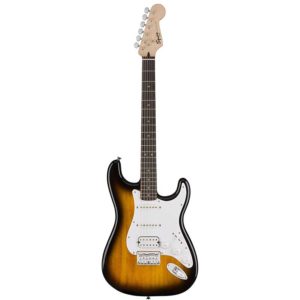 | Solid Body Pickups: HSS 22 frets | $180 | Read Full Review Below |
Here Are the Best Electric Guitars Under $1000
1. Fender Player Stratocaster (Best Strat)
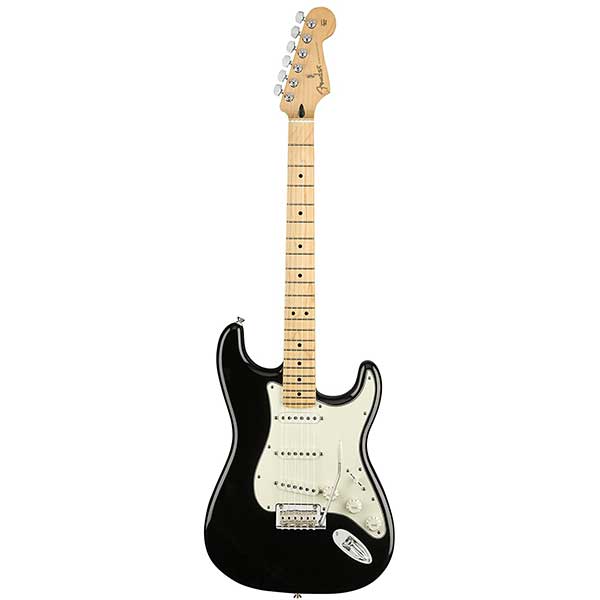
| Estimated Price | $700 |
| Body | Alder |
| Finish | Gloss Polyester |
| Colors | Sunburst, Black, Buttercream, Polar White, Sage Green Metallic, Sonic Red Tidepool, Silver |
| Neck | Modern C |
| Fretboard Radius | 9.5’’ |
| Frets | 22 medium-jumbo |
| Pickups | 3 Player Series Alnico 5 Strat single-coil |
| Tuners | Fender standard cast/sealed |
| Nut | Synthetic Bone |
My Review: I’m a big fan of Fender Stratocasters and own a few different models, including the one we’ll be discussing here. As you probably already know the Stratocaster is one of the most popular and iconic electric guitars ever created, with its roots dating back to 1954. Guitarists like Jimi Hendrix, Stevie Ray Vaughan, Jeff Beck, Eric Clapton, and Eric Johnson playing the Strat made it become a symbol in and of itself.
Stratocasters are known for their versatility and can be used in almost all styles from blues, rock, RnB, and jazz. The iconic single-coil sound of a Strat is incomparable and very distinctive. The five pickup combinations allow for a wide range of tones, each position mixed with the tone knob can be used for a specific sound that you’re going for. For example, the neck pickup of a Strat gives you that warm and thick tone. And the bridge pickup has a way more twangy and thinner sound. The neck pickup is used the most because it gives you that warm and gorgeous tone that can be used for most genres. But the bridge pickup is also often used for more punchy and thinner rock or country sound. The three other pickup positions – neck-middle, middle, and bridge-middle positions are also widely used. Middle and bride-middle positions are used a lot in funk guitar playing, and the neck-middle position has its own distinctive gorgeous tone that is slightly thinner than the neck position. John Mayer famously used the neck-middle position for a lot of his playing.
Due to Strat’s popularity, there are thousands of models and variations from Fender and other brands. Stratocasters produced from different time periods and different locations will sound slightly different. For example, a vintage American Strat from the 1990s and a Mexican Strat from 2010 will sound slightly different and will have different parts and features. People have their own preferences and I think it’s really a matter of taste. Mexican Strats have been a popular choice for many Fender users mainly for the price compared to American-made Strats, and some even prefer the Mexican Strats because of the price point. Sure, if we’re comparing specs, the American Strats have higher quality parts like more expensive body composition, better truss rod, better body finish. But there are definitely those “magic” Mexican Strats that have amazing tone and just feels right, and there are even guitarists like Nir Felder who found their “magic” Mexican Strat and have been playing for his whole career. So my conclusion from all this is that both American and Mexican Strats are a great choice, and it all depends on what your budget is, and how that particular instrument feels and sounds in your hands.
Let’s talk more about the newest version of the Mexican Strat, called the Fender Player Stratocaster. Launched in 2018, the American Player series is the latest line of models created for Fender made in Mexico. It has many similarities with the previous version (Mexican Standard Series), but the key differences include – body shape, pickups, and tone controls.
The player series, in general, went back to the vintage Fender vibe and tried to bring back more accurate original body shape and vintage-inspired finishes. The pickups had a huge upgrade – from previous Mexican Standard series’ ceramic bar magnet pickups to Alnico V magnet pickups, like a proper Fender Strat. Another feature is the new tone control system. The tone 1 knob on Player Strats controls both neck and middle pickups, and the tone 2 knob controls the bridge. The last upgrade is the guitar bridge – Fender implemented a 2-point Synchronized Tremolo Floating Bridge/Tailpiece, and this provides better tuning stability and maybe even better sustain. Other than that, some things that were kept from the previous model are the modern C neck shape, which provides very comfortable playing for your left hand, and the body is made of Alder and it features a Maple neck.
Fender Player Stratocaster is an amazing entry point Fender guitar, and it’s honestly a huge step up from the beginner guitars. With the Player Strats, you can hang with the experienced guitarists, and honestly, it’s one of the best choices for a guitar in this price range. It has many qualities that are very similar to the American Strats, and it is a Strat, it’ll give you a whole wide range of genres that you can play. From rock to blues to jazz to pop, I highly recommend the Player Stratocaster for intermediate guitarists looking for an upgrade, and or even to advanced guitarists that just want to have an extra Strat for gigging or recording purposes.
2. Fender Vintera 50s Telecaster (Best Tele)
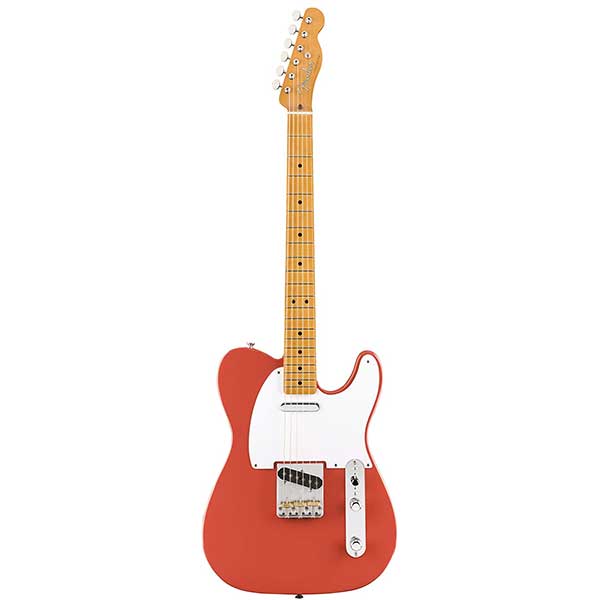
| Estimated Price | $900 |
| Body | Alder with a maple neck |
| Finish | Gloss Polyester |
| Colors | Fiesta Red (Vintage-tinted neck and vintage-inspired color) |
| Neck | U profile neck like the ‘50s Telecasters |
| Fretboard Radius | 7.25’’ |
| Frets | 21 vintage style |
| Pickups | ‘50s style Alnico V single coil |
| Tuners | Vintage style tuning machines |
| Nut | Synthetic Bone |
My Review: When talking about Fender, we have to talk about telecasters just as much as Stratocasters. Historically speaking, telecasters came out years before Leo Fender launched the first Stratocasters. These two guitars have been compared ever since then, and I’d say they’re equally great. While Fender Strats have their distinctive “glassy” Strat sound, and telecasters have more of a chameleon character to them. They blend super well to all kinds of genres, and it has a thicker sound than the classic Strat sound. Although not as popular as Stratocasters, telecasters have been used by artists playing country, blues, rock, jazz, to even metal. You can see legends like Keith Richards, Jimmy Page, Brad Paisley, Muddy Waters shredding on a telecaster. And just like Stratocasters, telecasters have a long history of various models and versions. There are literally thousands of possible telecasters you could buy, but in this review, I want to talk about a new reboot of the classic Telecaster.
The Vintera ‘50s Telecaster is Fender’s attempt to bring back the very first Telecaster models at an affordable price point. Compared to the newer Telecasters, the features are simple and rudimentary, but it has all the classic features of the early models that made the Telecasters what they are today. Just like the classic Telecasters, Vintera ‘50s feature a 3 saddle bridge with brass barrel saddles, vintage tuning machines, and 1 ply pickguard. Also, something that stands out compared to all other recent models, in the early ‘50s U profile neck. U profile neck is a lot thicker and has a totally different playing feel than the modern thinner necks. Although it won’t be as easy to play fast as the modern D or C shape, the vintage profile neck allows you to dig into your bends and vibratos a lot better. U profile neck is one of the qualities that many guitarists look for when they try to find a vintage Fender instrument. Like the early 50’s Teles, these guitars produce a biting and almost raw sound, and they are perfect for getting that classic rock, old pop, and blues tones. The bridge pickup produces a bright but slightly warmer tone, and the neck provides a mellow and soft tone.
Now you might wonder why the Vintera ‘50s Telecasters are so cheap. Why is it only $900 bucks compared to other Fender Telecasters that are $1500+? That’s because the Vintera line is produced in Mexico. Like I mentioned with the Stratocaster above, Mexico-produced Fender instruments are also top quality in many ways, and it will deliver amazing tones with similar quality parts as their American-made counterparts.
The Fender Vintera ‘50s Tele is a gorgeous and simple tribute to the original Telecaster at a very, very affordable price. The guitar looks vintage with its ‘50s style look and sounds vintage with the electronics and neck profile that is reminiscent of the traditional Tele. I’d recommend this guitar to all intermediate and advanced players, and maybe not to beginners because of the large neck profile. If you’re into the classic look and sound, get one of these before it’s too late!
3. Gibson Les Paul Studio Tribute (Best Single Cut)
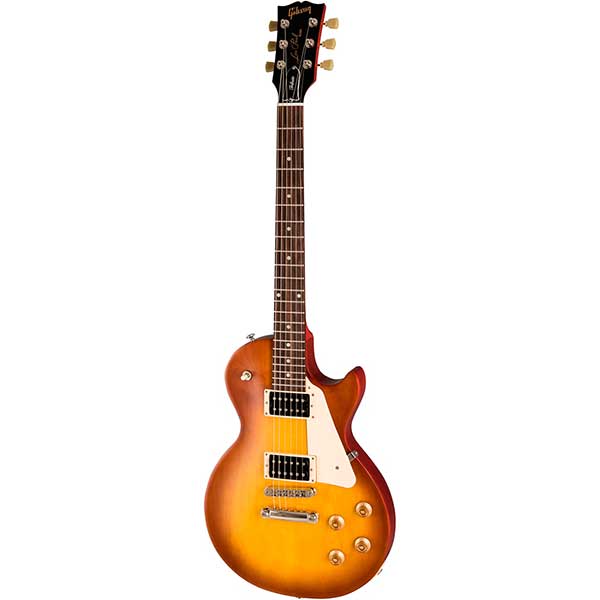
| Estimated Price | $1000 |
| Body | Mahogany with maple top (Weight relieved) Mahogany Neck |
| Finish | Satin |
| Colors | Iced Tea |
| Neck | Rounded |
| Fretboard Radius | Rosewood fingerboard with vintage-style frets |
| Frets | 12’’ |
| Pickups | 22 medium jumbo |
| Tuners | Gibson 490 R pickup for neck and 490 T pickup for the bridge |
| Nut | Synthetic Bone |
My Review: There aren’t many Gibson Les Paul models you can buy brand new for under $1000. The Gibson Les Paul Studio Tribute was made to be vintage sounding, and it has all the classic features of a vintage Les Paul without the modern Les Paul add-ons. They’ve eliminated some of the high-end specs like coil splits that the modern Gibson Les Pauls have, and in many ways, still kept the essential features that a vintage Les Paul would have.
Just like the vintage Gibsons, the Gibson Les Paul Studio has all mahogany body and neck and has a satin finish throughout the guitar. It also has a rosewood fretboard with a slim C neck profile, and with vintage size frets – perfect combinations to give you the same feel as playing a real vintage Gibson Les Paul. In terms of pickups, Gibson Les Paul Studio Tribute has dual 490 pickups – 490 R for neck and 490 T for the bridge. These are the same pickups that you would find on many high end Gibsons, and the magnet type is the classic Alnico II. This gives you the classic Les Paul sound – beautifully clean, crunchy sound as well as great lead guitar tone. Other than that, Les Paul Studio has a Tune-o-Matic bridge with a stop bar tailpiece like you would expect from a Gibson and also has vintage-style tuning machines. Overall, Gibson Les Paul Studio has all the best qualities from the vintage instruments, and for you Les Paul lovers, this is a chance for you to purchase a classic at a very affordable price point.
Related Article: Recommended Guitar Amps (All Price Ranges)
4. PRS SE Custom 24 (Best Overall)
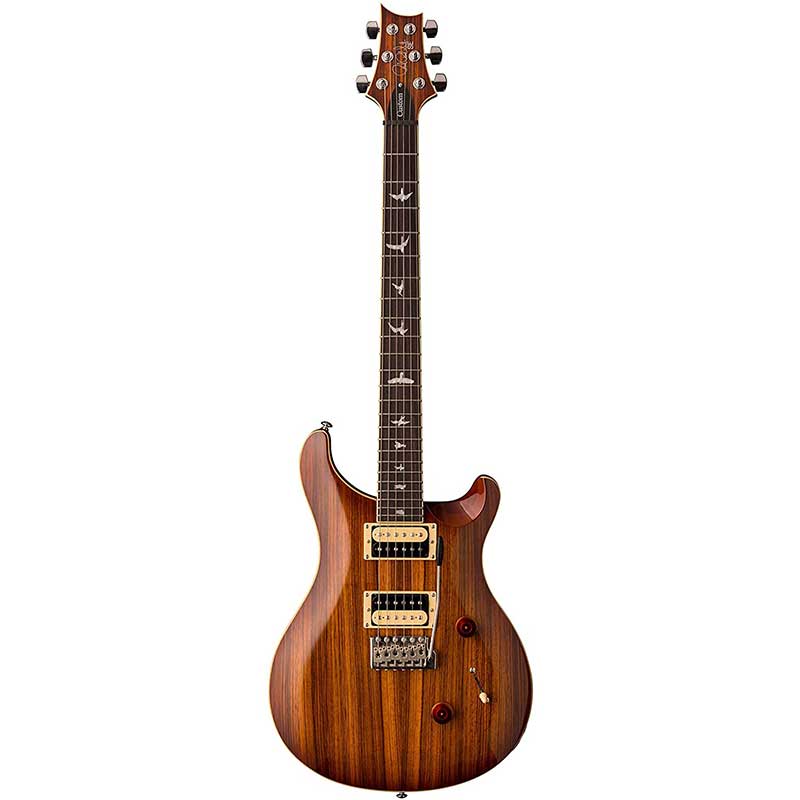
| Estimated Price | $850 |
| Body | Mahogany body with zebrawood top |
| Finish | |
| Colors | Vintage Sunburst |
| Neck | Glued maple neck with “Wide Thin” profile |
| Fretboard Radius | 10″ |
| Frets | 24 frets |
| Pickups | HH |
| Tuners | Standard E |
| Nut | Die-Cast |
My Review: PRS has been building high-end electric guitars since 1985, and they’ve had massive success over the years. They are clearly heavily influenced by Fender Strats and Gibson Les Pauls, but they always add their own brilliant touch to their models. You can almost think of PRS as a more modern version of preexisting commercial guitars such as Fender Strat, Gibson Les Paul etc, and they’ve been adding their own innovations over the years. PRS now has huge commercial success, and guitarists like John Mayer, Santana, Al Di Meola, and many more are endorsing this brand.
The PRS SE Custom 24 has been a long fan favorite, and way more affordable compared to the traditional PRS high-end guitars. PRS SE Custom has been in production since 2001, produced in South Korea. You can almost think of these guys as the perfect lightweight gigging guitars, as they are extremely versatile. PRS SE Custom 24 has a flat maple top as opposed to the PRS high end carved style body, which was another way that PRS was able to bring the cost down by so much. And they feature the familiar looking bird inlays on the fretboard and Pearloid inlays between the frets.
The general shape was inspired by the Santa signature PRS model – a longer horn on the body and a thinner waist than the other PRS guitars. The ergonomic design of the PRS allows you to access all 24 frets easily, which seems to a common theme among the modern solid body guitars. PRS SE Custom models also have gorgeous finishes and the detail they put into the finish is really mesmerizing. Now let’s talk pickups. From a more affordable model, you’d expect cheaper pickups. PRS SE Custom models have Korean made PRS 85/15s humbuckers. They were designed to have both great single coil and humbuckers sounds, and PRS SE Custom also has a coil split function. The technology for the PRS coil-split is slightly different from the standard coil split that we might expect. The standard coil-split will completely turn off one side of the humbucker, and only give you the single coil sound. These PRS coil-split, on the other hand, will leave 10% (neck) or 16% (bridge) of the other part of the humbucker still on the circuit, and this results in a slightly thicker and warmer sound than the standard coil-split. In terms of tone, the bridge pickup provides a subtle but enough midrange, and it’s perfect for blues and classic rock sounds. The neck is more expressive and warm and has a similar quality to Gibson PAF type sound. And like I mentioned before, the coil splits give you a wider tonal variety and you can access a Strat-like single coil sound. All in all, if the Music Man and ESP models were more for hard rock and metal, this PRS SE Custom 24 is more for genres like blues, pop, and classic rock. It might be a lot more versatile for gigging purposes, and it also comes in jaw-droppingly beautiful finishes, so check them out before the prices go up!
5. Chapman ML1 Modern V2 Electric Guitar (Best Value)
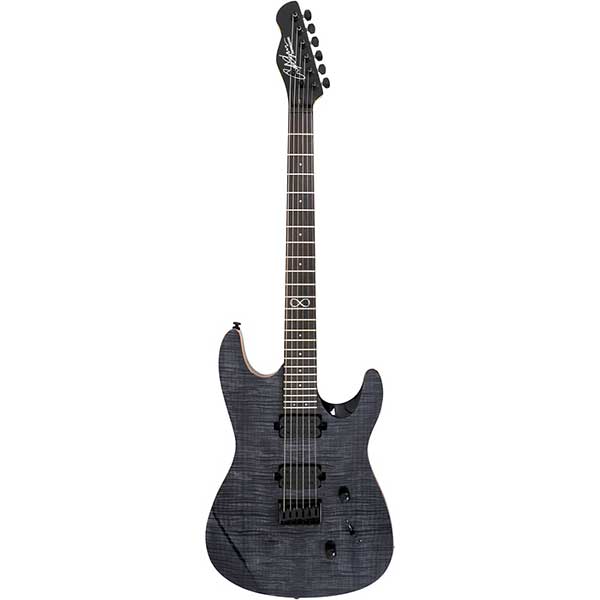
| Estimated Price | $500 |
| Body | Mahogany |
| Finish | Gloss |
| Colors | Ebony |
| Neck | Maple with a satin finish |
| Fretboard Radius | 12″ |
| Frets | 24 frets |
| Pickups | Switch 3-way blade switch with coil split on a push-pull tone knob |
| Tuners | Chapman classic closed (18:1 gearing) |
| Nut | Graph tech black TUSQ XL nut |
My Review: Chapman guitars are a relatively new company, getting its start back in 2009 by popular Youtube guitarist Rob Chapman. They’re a small British company that focuses on high quality but affordable guitars. One of Chapman Guitars’ goals as a brand is to bring the price of their instrument down by not using a traditional distribution model.
I would describe Chapman ML1 Modern V2 as an affordable guitar with materials, specs, and build quality that rivals many higher-end guitars. The design of ML1 Modern V2 is Chapman’s take of the Superstrat, and it has a glossy mahogany body with a flame maple top. Something that stands out is the reversed headstock, which has a unique shape, but it’s something that might be awkward for players to get used to. The guitar neck is a very comfortable C profile neck and has 24 frets but a maximum range. The contoured neck heel shape of the body helps you reach all the way up to the 24th fret easily.
For pickups, Chapman ML1 Modern V2 has Chapman’s own Ceramic Sonorous Zero humbuckers, and the characteristic of this pickup is that they are very loud with clarity. And they work perfectly for playing with hard distortion and overdrive and a lot of other effects. Another thing to add about the pickups is that they have the push/pull coil split function, which comes in extremely handy for humbucker guitars. You can also get the single coil sound along with the heavy humbucker tone, and they can be helpful for playing strat-like rhythm guitar. For anyone looking for a shredding guitar with diverse tones, the Chapman ML1 Modern V2 is a great choice. In my opinion, this is the best electric guitar under 1000 dollars if you consider price and overall quality.
Related Article: Review of Our Favorite Mini Guitar Amps
6. Yamaha Revstar RS502T
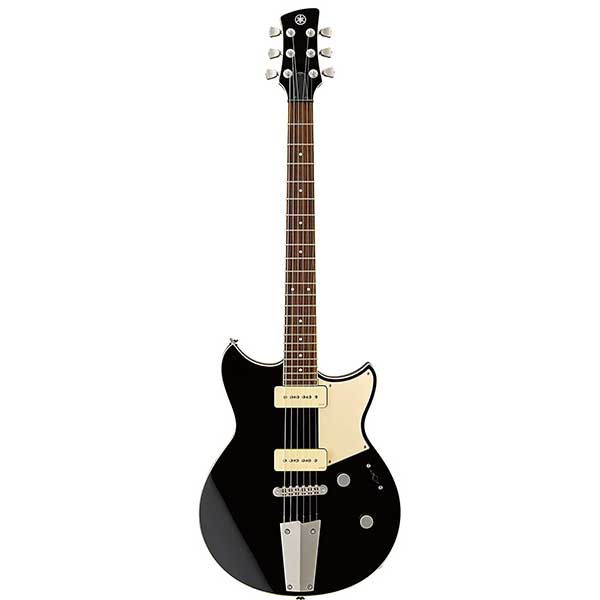
| Estimated Price | $650 |
| Body | Mahogany body with maple top |
| Finish | High gloss |
| Colors | Satin Nickel |
| Neck | Mahogany neck |
| Fretboard Radius | 12.75″ |
| Frets | 22 frets |
| Pickups | VP5 Alnico V P-90 single coil pickups |
| Tuners | Diecast |
| Nut | 43 mm |
My Review: Yamaha is a company known for pianos, motorcycles, and hundreds of other products. But among them, is their line of guitars. In the guitar industry, they are known for producing affordable guitars that are sturdy and good for the price, and also known for some innovative designs and features.
Yamaha Revstar RS502T is part of the fairly recent line of electric guitars produced by Yamaha – Revstar series. Like the Music Man Majesty guitars, the Revstar series is inspired by vintage motorcycles, and the RS502T has a Brian May Red Special-like unique design with many similar qualities to a Gibson Les Paul. Like Gibson guitars, Revstar RS502T has all mahogany body with a maple top, mahogany neck, and rose fingerboard with 22 frets. The shape of the guitar was designed to fit very comfortably around your body, both for your legs and your arms on the body.
A fair amount of consideration was put into the tone, and it features VP5 Alnico V P-90 single coil pickups, and just like you would expect from P-90 pickups, the tone is aggressive and in-your-face type guitar tone. It could be described as having a tight low end and full mid-range. Yamaha has also put in their own version of a coil split, called a Dry switch. When you enable the Dry switch, it cuts some of the lows and it results in a more punch, fat Strat sound. Other features like set-neck construction also help with the sustain of the instrument. Although this is a quite versatile guitar, I would imagine it would be best suited to genres like rock, blues, and funk. Overall a very unique guitar with unique specs, and it’s a great instrument that would best suit the guitar players looking for uncommon designs. This is easily one of the best electric guitars under 1000 dollars.
7. Charvel Pro-Mod So-Cal Style 1 HH FR
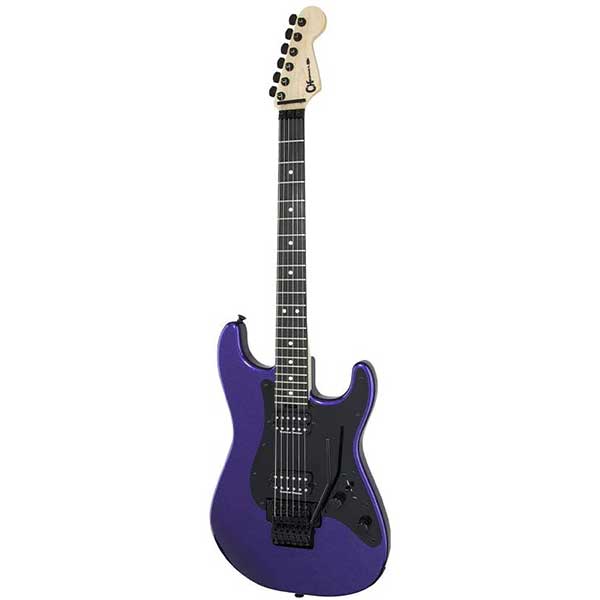
| Estimated Price | $900 |
| Body | Alder wood |
| Finish | Satin |
| Colors | Snow white |
| Neck | Maple wood |
| Fretboard Radius | 12″-16″ |
| Frets | 22 Fat frets – 25 ½ inch scale length |
| Pickups | Seymour Duncan Distortion humbuckers – TB-6 for bridge and SH-6N for neck |
| Tuners | Charvel-Branded Die-Cast |
| Nut | Floyd Rose 1000 Series Locking |
My Review: Charvel is another one of those brands that you will hear about once in a while, and they’ve been around since the 1970s. Like Jackson Guitars, they started out in California as a guitar shop producing rock and metal guitars based on Fender designs, and now Fender has bought the company, and Charvel continues to produce high quality rock and metal guitars.
Charvel Pro-Mod So-Cal Style 1 HH Fr is another Superstrat, and they’re made with premium components, but available in a pricepoint that won’t break your bank. It has an alder body with two piece maple neck, and Charvel is known for making guitars with fat frets, and this one isn’t an exception. It has 22 jumbo frets with a scale length of 25 ½ inches and has a thin “speed neck profile” to let you move around the neck as fast as possible.
When it comes to pickups, Charvel Pro-Mod HH FR is loaded with Seymour Duncan Distortion pickups – TB-6 for the bridge and SH-6N for the neck. They are ceramic high output humbuckers that have been around since the ‘80s, and they will get the job done well for sure. As the name suggests, these Distortion pickups have a huge sound output with full bottom, mid, and searing highs – just what you need for cranking maximum tone on those power chords, palm muting, and shredding. And like all the modern guitars we talked about, they also come with coil tap function in the master volume knob – just to give you that extra clean bright tone option. Other than that, Charvel also invested in high quality Floyd Rose double locking tremolo, and these high quality tremolo bars will make sure your guitar stays in tune even after wild tremolo bar bending and shredding. Maybe not as versatile as some of the other guitars, but the Charvel Pro-Mod So-Cal Style 1 HH FR should also be on the top of your list for you metalheads and hardcore rock and rollers, especially for a guitar under $1000.
Popular Article: Great Microphones for Guitar Amps
8. Epiphone 1959 Les Paul Standard
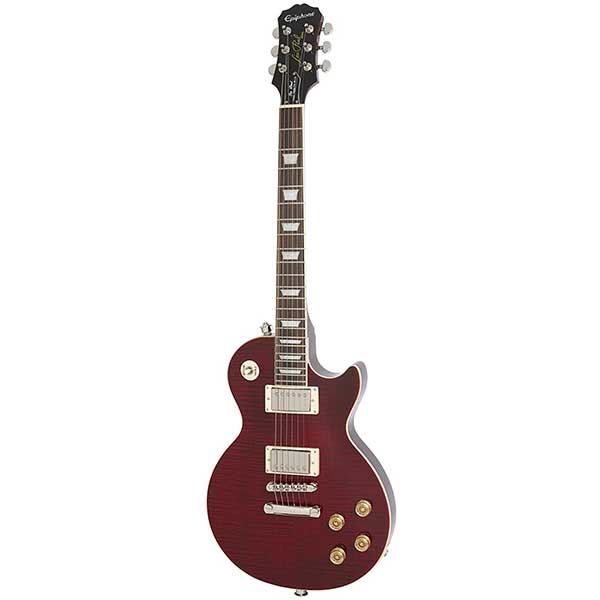
| Estimated Price | $800 |
| Body | Mahogany |
| Finish | Other |
| Colors | Aged Dark Burst |
| Neck | Mahogany (Rounded C) |
| Fretboard Radius | 12″ |
| Frets | 22 frets |
| Pickups | Burstbucker humbucker pickups |
| Tuners | Vintage-style |
| Nut | 1.69 in. (43 mm) GraphTech |
My Review: Gibson Les Paul has been at the forefront of electric guitars along with Stratocasters and Telecasters. They weren’t as popular as a Strat or a Tele but were equally influential in the history of electric guitars. When they first came out in the early ’50s, Gibson Les Pauls were not popular at all compared to the Fender Strats and Teles. The ones that saved Les Paul guitars were the British guitarists during the British Invasion of American music. Inspired by the African American blues musicians, legendary guitarists such as Keith Richards, Eric Clapton, and Jimmy Page got their hands on a Gibson Les Paul. By these cultural icons playing Gibson Les Paul, they really helped to showcase Les Paul in the mainstream Rock and Roll scene.
The Epiphone guitar is closely related to Gibson in many ways. Along with Gibson and Fender, Epiphone was there since the beginning – making instruments since 1873. They were one of Gibson’s biggest rivals during the 1920-1930s and had a huge commercial success with their own line of guitars. But after World War II, everything changed. They faced huge financial problems and Epiphone was finally bought off by Gibson in 1957. Gibson originally planned to just use Epiphone bass models, but they decided to rebrand Epiphone, and now Epiphone was reborn as the budget conscious brand for Gibson. Even now, Epiphone still produces affordable versions of Gibson classics, as well as their own designs.
The Epiphone 1959 Les Paul Standard Outfit was inspired by the Gibson 1959 Les Paul – which is thought to be the dream guitar for many guitarists. The 1959 Les Paul was the pinnacle of Les Pauls and it was the year that Gibson finally got their PAF pickups right. The real 1959 Les Pauls are worth hundreds of thousands of dollars, and there are only a little over 1,000 of them left in this world. Gibson did make reissues of the 1959 Les Paul, but they cost well over $5000 and so Epiphone decided to make their budget friendly versions of the legendary guitar. The Epiphone 1959 Les Paul Standard Outfit maintains the many qualities that make the legendary guitar, such as the mahogany body and mahogany neck, larger Gibson ‘50s style neck profile to electronics. Just like its Gibson counterpart, Epiphone’s version comes with high quality CTS pots and the Burstbucker 2 and 3 humbuckers. The tone can be compared to a Marshall Stack overdrive vintage sound – warm and thick tone that made the 1959 Les Pauls legendary. Other than that, the Epiphone’s version also comes with Kluson style machine heads for precise tuning and tuning stability, as well as the classic Tune-o-Matic bridge w/ stop bar tailpiece. The volume and tone controls are all independent classic knobs, and it comes with the classic 3-way pickup selector. It’s almost too good to be true for a very close replica of the 1959 Les Paul in the price of just $799, and it’s perfect for anyone that dreamt of getting that 1959 Les Paul sound. I’d also recommend this for any serious Les Paul guitarists looking to get a touring and live guitar that you can rely on, and of course, it’d a great guitar for all the beginners and intermediate guitar players trying to get that classic rock and blues sound.
9. Epiphone SG Standard 61
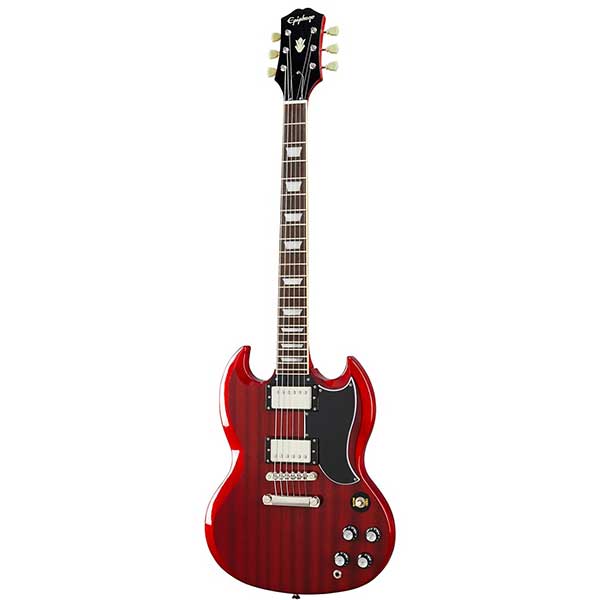
| Estimated Price | $450 |
| Body | Mahogany |
| Finish | Nickel |
| Colors | Vintage Cherry |
| Neck | Mahogany( SlimTaper) |
| Fretboard Radius | – |
| Frets | 22 frets |
| Pickups | 3-way Epiphone toggle |
| Tuners | Epiphone Deluxe Vintage machine heads, 18:1 ratio |
| Nut | Graph Tech |
My Review: Whether it’s from the hands of Derek Trucks or Angus Young, you probably have seen this guitar a whole lot. Launched in 1961, the Gibson SG model is short for “solid guitar”, and it was one of the first guitars that were released after Gibson ended the contract with Les Paul. They were descendants of the Gibson Les Paul, created after Gibson was experimenting with smaller versions of the Les Paul guitar – Les Paul Junior, TV and Special models. They soon made a thinner, double cutaway version of those guitars, and a few years later, that guitar became the Gibson SG. It was only after 1963 where that model officially became the Gibson SG, after Les Paul’s endorsement contract ended in 1962 with Gibson. This was a way for Gibson to respond to their competitors Fender and Gretsch, and especially Fender was launching instant hits after hits with their new models. But for Gibson, it took them years to really master their SG model, and one of the final pieces was the ABR-1 (tune-o-Matic bridge) and PAF (pickups). After the 1960s, and 1970s, the Gibson SG became their most popular model, and the SG soon became an iconic solid body guitar of the 20th century.
The shocking thing about a good SG is how much sound it produces from such a small body. When on full blast, it resonates super well and creates such a deep overdrive and distortion tone. SG has its own personality to it, you’ll know what I mean if you listen to Angus Young’s playing. Gibson’s mahogany construction adds a touch of brightness and provides plenty of sustain. Another shocking thing about Gibson is its tonal variety and genre diversity. From Sister Rosetta Tharpe to Spinal Tap’s Nigel Tufnel to Derek Trucks, this thing nails so many different styles.
Like the guitars above, the Epiphone SG Standard ‘61 is an effort to replicate the Gibson SG ‘61 at a very affordable price point, and it has a shocking price of almost ¼ of Gibson’s reissue version of the same guitar. Now looking at the price, you might wonder if it’s actually possible to be this cheap. Let’s first look at how the features on the Epiphone SG Standard ‘61 compares with the Gibson’s version. Looking at the pickups, Epiphone’s version comes with ProBucker Alnico II pickups. ProBucker pickups are Epiphone’s groundbreaking pickups that were invented to duplicate the vintage Gibson pickups, and it fools even the experienced luthiers. The quality is astonishing considering the price, and just like the classic SG, Epiphone SG Standard ‘61 has Alnico II magnets. And just like its Gibson counterpart, it has all mahogany body and neck, with Slim Taper neck – following the SG tradition. Other than that, Epiphone SG comes with Indian Laurel fretboard, with GraphTech Nut for maximum sustain. The tone is similar to Gibson’s OG and has a rich, warm tone that can be used for many genres like rock, blues, jazz, pop, metal, fusion, and beyond. If you’re into the SG shape and sound, the Epiphone SG Standard ‘61 is an amazing choice.
Related Article: Our Favorite Starter Electric Guitars
10. Epiphone Sheraton-II Pro
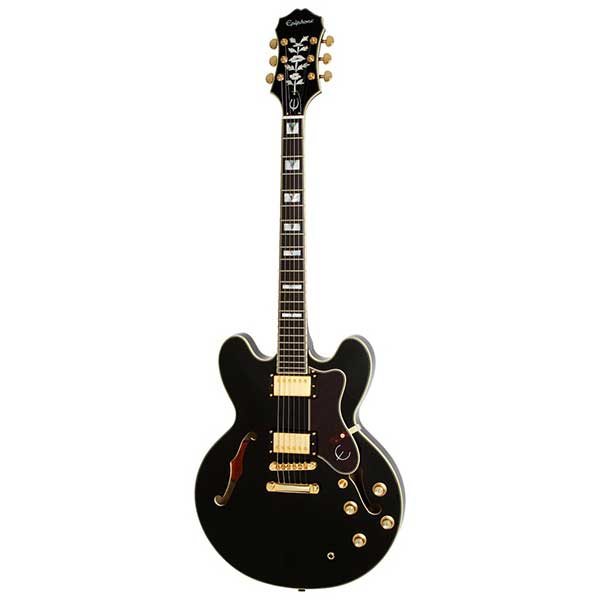
| Estimated Price | $700 |
| Body | Layered Maple |
| Finish | Gloss |
| Colors | Wine red, Midnight Sapphire, Vintage Sunburst |
| Neck | 5-pc Layered Hard Maple/Walnut( 60s SlimTaper) |
| Fretboard Radius | 12″ |
| Frets | 22 frets |
| Pickups | Two ProBucker pickups with coil tapping function |
| Tuners | Grover Rotomatics; 18:1 ratio |
| Nut | Graphtech, NuBone XL |
My Review: Sheraton II Pro is a little different compared to the previous 2 Epiphone models that we introduced. The difference is that the two previous Epiphone models were almost exact affordable clones of a pre-existing Gibson model, and Sheraton is Epiphone’s own creation. Sure, they were inspired by Gibson ES-335, but Sheraton is Epiphone’s own creation and they were in production since the 1950s. They are one of the most popular guitars from Epiphone, and the quality speaks for itself.
Following the ES-335, Sheraton has a double horned body with a large center block. The large center block provides a hollow body-like acoustic sound minus the feedback. This is why semi hollow body guitars are so popular because while it still retains the deep, warm resonant tone of a hollow body, the minimal feedback allows you to use various distortion and overdrive. This makes the Sheraton II Pros super versatile, allowing you to play genres all across the board from jazz and blues to rock and country. The body of Sheraton II Pro is comprised of laminated maple body and top, and it’s made up of 5-piece hard maple and walnut combination. The fretboard is a cross between rosewood and mahogany fretboard, a type of wood called Pau Ferro. Other than that, Sheraton has the classic Gibson scale length of 24.75’’ and 12’’ fretboard radius for maximum comfort and tone.
Just like the Epiphone SGs, Sheraton II Pro is equipped with Epiphone’s own ProBucker humbuckers, and these on a semi-hollow guitar will be perfect for its versatile use – from warm clean tone to gritty overdrive. It has two volume and two tone knobs and has a modern addition to the guitar – the coil split. The coil split function will deactivate one side of the humbucker, and give you a single coil sound. This combined with the three way pickup selector will give you so many tone variations just with the controls on the guitar. In terms of hardware, Sheraton II Pro comes with a Tune-o-Matic bridge with LockTone stop bar, Grover Rotomatic tuning pegs, and GraphTech Nut.
Visually, Sheraton II Pro is a beauty. One of its charming aspects is the fretboard inlay, and Epiphone has put mother pearl and abalone inlays on the fretboard, and they just look gorgeous and matches perfectly with the tone of the guitar. The basic tone of the guitar without effects on the neck the pickup is a warm and luxurious tone with a fair amount of bass and mids. It’s the tone you’d want for playing straight ahead jazz, Brazilian jazz, to even blues. Compared to the solid body, you’d think they might lack the treble, but that’s where the bridge pickup comes in. The bridge pickup sound is more sharp and trebly, and it’s perfect for rock and country. Overall, there’s a reason why Sheratons have been so popular throughout its almost 70 years of production, and like with the other Epiphone guitars, the price for quality is outright insane. This is a type of guitar that can be used for professional guitarists for recording and touring, but obviously, the price point allows for guitar players at all levels to purchase one.
11. Ibanez Genesis Collection RG550
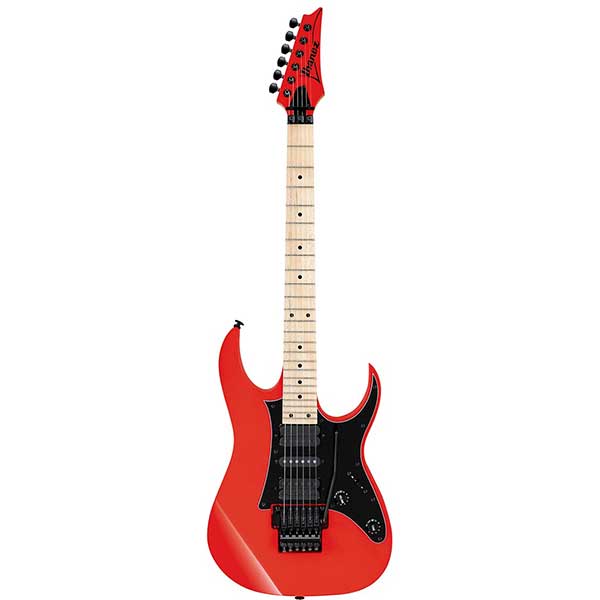
| Estimated Price | $1000 |
| Body | Basswood body with 5 piece maple |
| Finish | Info not available |
| Colors | Road Flare Red, Desert Sun Yellow, Gloss White |
| Neck | Super Wizard5pc Maple/Walnut neck |
| Fretboard Radius | – |
| Frets | 24 frets |
| Pickups | HSH pickup configuration with V7 bridge humbucker and V8 neck humbucker |
| Tuners | Gotoh MG-T machine heads |
| Nut | 43mm |
My Review: Ibanez is one of the most diverse music companies in the biz, and they’ve created some of the best solid body guitars with their new technology, amazing semi hollow and hollow bodies, acoustic guitars, as well as top of the line guitar pedals. The company is always looking for ways to evolve and explore new possibilities. During the 1980s, Ibanez was always regarded as the “cool” and innovative brand. One of the most popular rock guitar in the late ‘80s was the Ibanez RG550. It was made as a more affordable version of Steve Vai’s one and only JEM guitars, and they were in production between 1987 and were discontinued in 1994. But recently, Ibanez revived the classic shredding machine with amazing specs and quality.
Ibanez RG550 Genesis is a true shredding machine that was built for the technical guitarists. The neck is something called the Super Wizard neck, and it’s designed for fast runs, comfortable arpeggios, tapping, big bends, and all sorts of modern techniques. There are 24 jumbo frets and the body contour allows you to reach all the way up to the 24th fret without any problem. In terms of pickups, it has a HSH configuration – humbucker – single coil – humbucker. V7 bridge humbucker has a sharp, biting quality to it and V8 neck humbucker has a much warmer and compressed lead guitar tone with clear overtones. And when you set the pickups to the middle position, you can access the S1 single coil, and get that traditional, high single coil sound.
The body is made up of basswood, which generally gives a tone full with clear mids, and it also has the Ibanez Edge locking tremolo for precise intonation and the full range of motion on the tremolo bar. It’s also offered in very futuristic finishing color options like Purple Neon, Desert Sun Yellow, Ruby Red, and Laser Blue. Ibanez RG550 Genesis is truly a beautiful modern guitar that gives you so much versatility within one instrument. The price is definitely higher than the previous guitars that we talked about, but if you are someone that plays a very technical style of guitar that needs all 24 frets, Ibanez RG550 would be an amazing addition. If you’re looking for the best electric guitar under 1000 dollars this guitar should certainly be in the running.
Related Article: 17 Best Wireless Guitar Systems on the Market Right Now
12. D’angelico Premier Bedford
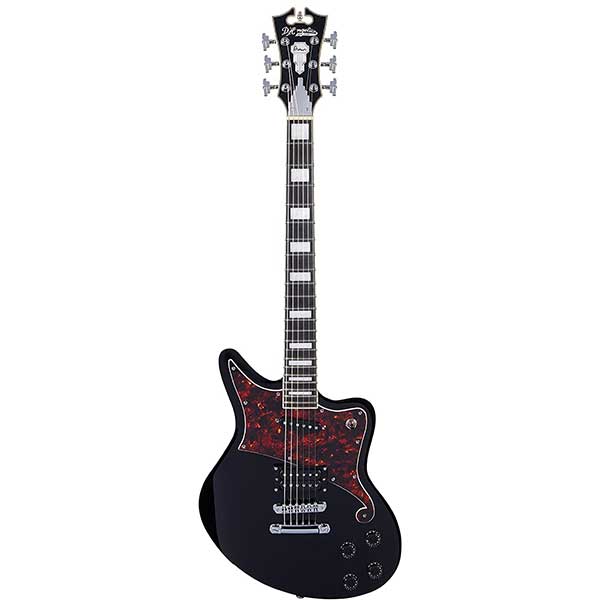
| Estimated Price | $700 |
| Body | Basswood body, Antique White |
| Finish | Gloss |
| Colors | Army Green, Black, Antique White |
| Neck | Comfortable C-profile maple neck |
| Fretboard Radius | 14″ |
| Frets | 22 frets |
| Pickups | HB-101B humbucker bridge pickup |
| Tuners | Rotomatic “Stairstep” |
| Nut | PPS Plastic |
My Review: There is a legendary guitar company that is not as well known to the general public as Fender, Gibson, or Gretsch, but in my opinion, equally as important and revolutionary. They’re called D’angelico Guitars, and it was created by one man, a luthier – John D’angelico. After becoming an apprentice of violin and mandolin maker at the age of 9, he took all that expertise and built his own company in NYC’s Little Italy in 1932. He produced some of the best performing and most beautiful archtop guitars, and he only had two assistants helping him out. John unexpectedly died of a heart attack in 1964, and one of his apprentices Jimmy D’Aquisto bought the company, and that was the end of D’angelico for a while. But in 1999, a group of guys bought the D’angelico name, and Brenden Cohen relaunched D’angelico in 2010. After Cohen took over the company, D’angelico took a more commercial turn, and they looked at ways to put the D’angelico guitars on the market for a cheaper price. Before 2010, D’angelico guitars were THE dream guitar for a jazz guitarist, and the price made it hard to buy. And it makes sense because the original D’angelico guitars were hand made by John D’angelico and his two assistants. But they were able to bring a very affordable priced D’angelicos to the market by moving the production to Japan and Korea.
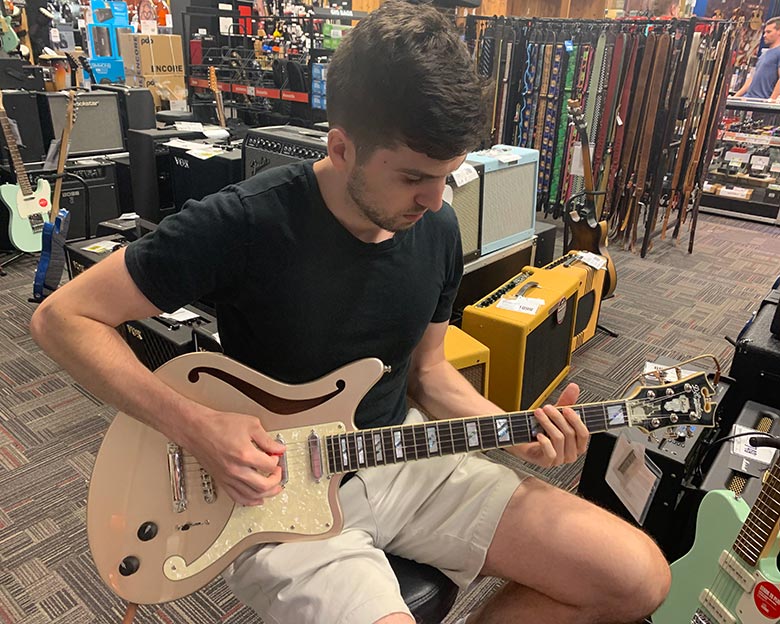
Ever since their relaunch, D’angelico has been producing some of the most beautiful electric guitars that are commercially available. Following their tradition, they originally focused on just hollow body and semi hollow body guitars, but they released their solid body guitars in recent years. Many new solid body models in the current market are a copy of either Strat, Tele, or Les Paul with minor adjustments. But D’angelico reimagined how a good solid body guitar should look like, and created their own signature shapes. Even though their solid body lines look completely different from their original hollow body guitars, there’s a definite sense of elegance and classy vibe that all of these guitars have. It might be the shiny hardware that these guitars have, or the body finish or the shape, but the feeling you get when you look at a D’angelico is the same. Since then, they already have guitar legends like Bob Weir, Kurt Rosenwinkel, Isaiah Sharkey using D’angelico solid body guitars.
D’angelico Premier Bedford is part of one of the cheaper guitar lines produced by D’angelico, and the Premier lines feature three solid body guitar shapes – Ludlow, Atlantic, and Bedford. The shape of Bedford is very unique, with an f-hole pickguard combined with a curly offset guitar body. I would describe the Premier Bedford is the perfect mixture of Gibson and Fender, in terms of shape and electronics. The offset body gives players a lot of space and makes it easy to access all 22 frets. The body is a basswood body and the neck is a C-shaped maple neck. The neck also stands out, because the neck is clearly unfinished and has a very tiny neck joint – and this makes this instrument more unique than any other guitar out there.
Just like Gibson guitars, the fretboard features block inlay, and it’s made up of Ovangkol material. And similarly to Gibson models, Bedford has four knob controls with two volume knobs and two tone knobs. But something that is completely different, is the coil tap function on both neck and bridge pickups. The coil tap functions allow you to access another type of sound, and you can separate both the neck and bridge pickups into a single coil sound. The neck pickup is a Seymour Duncan STK single coil, which is a unique hot two stack single coil. What it means is although it’s not as powerful as humbuckers, STK single coils pack much more current than a single coil. The neck pickup by itself has a spanky, and thin Fender-like tone, which is perfect for rhythm guitar playing like strumming and cutting. The bridge pickup is a Seymour Duncan HB-101B humbucker, and it’s a lot more punch and thicker than the neck pickup. These tones combined with middle position and coil tapping, you can access a variety of tones from spanky and thin all the way to warm humbucker sound.
Other than that, Premier Bedford has the classic Gibson style Tune-o-Matic bridge, which is always a reliable choice for any electric guitar, and it comes with Rotomatic Stairstep Tuning machines. So overall, Premier Bedford is a perfect mix of Fender and Gibson, and a perfect mix of new and the old D’angelico – a combination of both new features on a solid body, and old traditional features from the D’angelico hollow body guitars that came before.
13. ESP LTD EC-1000
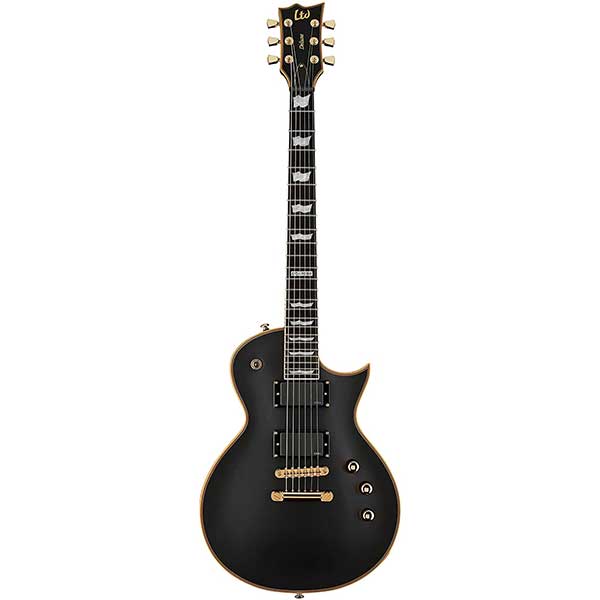
| Estimated Price | $1000 |
| Body | Mahogany body |
| Finish | Black |
| Colors | Black, Vintage Black, Amber Sunburst, See Through (black, green, Purple) |
| Neck | Thin U neck profile with a mahogany neck |
| Fretboard Radius | 13.8″ |
| Frets | 24 frets |
| Pickups | Two knobs for individual pickup volumes, and master tone kno |
| Tuners | LTD Locking |
| Nut | Molded |
My Review: ESP stands for Electronic Sounds Products, and they started out as a shop in Tokyo making replacement parts for guitars in 1975. Since then, they started producing their own line of high quality solid body electric guitars and started exporting them to the US in 1983. ESP gained fame after guitarists like George Lynch and James Hatfield came out with their own ESP signature models, and became one of the fastest-growing guitar companies in the early 2000s. Many metal and hard rock guitarists such as David Mustaine of Megadeth and Jeff Hanneman of Slayer left Jackson to join ESP. Even now, they remain one of the top guitar manufacturing company for hard rock and metal guitarists.
You can think of ESP LTD EC-1000 as a high-end quality guitar but offered for just under $1000. For the price, the elegant black look with gold color hardware is shocking, and not only that, it has a very luxurious looking Pearloid Flags inlay on the fretboard. It’s obvious that these were inspired by the classic Gibson Les Paul shape, and has many similarities to a Les Paul. Just like a Les Paul, LTD EC-1000 is built with solid mahogany, and three-piece mahogany for the neck. The mahogany neck has a rosewood fretboard, with 24 extra-jumbo frets. It’s built for aggressive playing, built to withstand hardcore shredding and hard bending. In terms of neck profile, LTD EC-1000 has a thin U neck profile, providing an amazingly comfortable grip and allows players to shred and move around with ease.
Built for maximum power, EC-1000 features aggressive active EMG humbuckers. It has an EMG 60 humbucker for the neck and an EMG 81 humbucker for the bridge. It has two knobs for controlling the volume of each pickup, and a master tone knob to control the overall balance. EC-1000 also features the classic three-way toggle switch to select your pickup. In terms of sound, LTD EC-1000 packs a heavy and powerful distortion, full with mid and bass. The hardcore bridge pickup is built for shredding, chunky rhythm playing, and also allows playing wailing harmonics. The neck pickup is great for beautiful lead guitar soloing, and it can also provide crystal clear clean tones. And because this guitar is built to withstand rough playing, it features TonePros Locking tune-o-Matic bridge and LTD locking tuners for tuning stability. Overall, it’s very rare to find a metal guitar that has better specs and sound in this price range. If you need a shredding guitar for hard rock or metal, the ESP LTD EC-1000 is for you.
14. Sterling by Music Man MAJ100
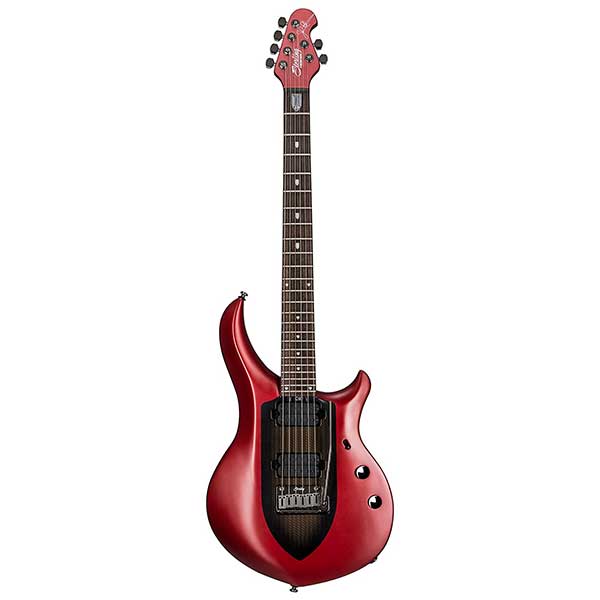
| Estimated Price | $905 |
| Body | Mahogany body |
| Finish | Gloss |
| Colors | Iced Crimson Red |
| Neck | Mahogany neck (Petrucci) |
| Fretboard Radius | 16″ |
| Frets | 24 frets |
| Pickups | Twin Sterling humbuckers with 12dB gain boost |
| Tuners | Locking tuners with classic Music Man headstock |
| Nut | 1.65 in. (42 mm) |
My Review: Music Man was founded in 1974, and they were first known as a company that introduced active electronics on their production lines. The famous music accessories entrepreneur Ernie Ball’s son Sterling Ball – who is a legendary instrument designer and a musician by his own right – was on the team since the 1970s. He helped develop the famous StringRay Basses, and Ernie Ball company officially bought Music Man in 1984. In 2001, they teamed up with John Petrucci, one of the all-time great metal guitarists, and launched John’s first signature model: The JP6. Ever since then, John Petrucci and the team at Music Man never stopped innovating and developing and created a total of 9 signature John Petrucci signature guitars. The amazing thing about his signature lines is that John personally always uses his signature guitars in his Dream Theater tours, recordings, and songwriting process. This is quite rare in the guitar world because many guitarists with their signature line will use multiple different guitars when they are actually playing on stage. But John exclusively uses his signature models, and over time, he was able to gather all kinds of feedback, make adjustments, and do experiments to create the best possible instrument. With over 18 years of experimenting and developing multiple signature models, the one and only Majesty was born. It’s THE pinnacle of all his creations and his Majesty is simply put, one of the best signature guitars you’ll find anywhere.
Sterling by Music Man is the cheaper line of Music Man guitars, similar to what Epiphone is to Gibson. It gives people with a lot of smaller budgets to experience the excellence of Music Man instruments. In terms of Majesty MAJ100, it’s directly influenced and is very similar to the original American made Majesty models. The reason for the cheaper price is that the Sterling by Music Man line is manufactured in Indonesia, while all the designing is done back in California headquarters. The design of the Majesty is said to be inspired by sports cars and running stallions, and it’s pretty obvious when you look at these. It’s designed for the most ergonomic use, and it’s built as a set neck type guitar. Three-piece mahogany neck is sculpted onto a contoured mahogany body, and because it’s made up of mahogany, the guitar only weighs around 2.9kg. In terms of hardware, Majesty MAJ100 has chrome hardware with six floating saddle bridge and a push-in tremolo bar, combined with locking tuners. This allows you to bend notes and press into the tremolo bar as much as you want, without having to worry about the strings going out of tune. Just like the original Majesty models, these also have 24 medium jumbo frets, and the ergonomic body shape gives you unrestricted access to all 24 frets. The neck profile is slightly thicker than the original, and it has a comfortable C profile neck. This might throw off shredding guitarists who prefer very thin necks, but I personally prefer C profile neck because it gives me a better grip on the notes I’m playing.
Majesty MAJ100 features pickups that are low quality than the American made original – twin Sterling humbuckers. The original Majesty models have the custom DiMarzio Rainmaker and Dreamcatcher pickups, which many people think of as the highlight of the Majesty models. So that’s a little disappointing for Majesty MAJ100, but that was also one of the reasons why the American models were way above $3000. Sterling pickups don’t have the same kind of clarity and range as the DiMarzio ones, but the Sterling pickups are still very clear and responsive pickups. The pickups respond very well to distortion, and it makes a perfect guitar for amazing lead guitar playing and powerful rhythm guitar playing. The 12dB boost feature is mindblowing, and it adds another layer of punch and power to the guitar tone, just when you thought you had enough power in your sound. Overall, the Sterling by Music Man Majesty MAJ100 is an extremely high-quality guitar for the price range, and I recommend this to rock, hard rock, and metal guitarists. One disappointing factor might be that these don’t have the same quality pickups as the original, but considering the price, I still think it’s a top-of-the-line instrument built for maximum shredding and comfort.
15. Gretsch G5420T Electromatic Hollow Body
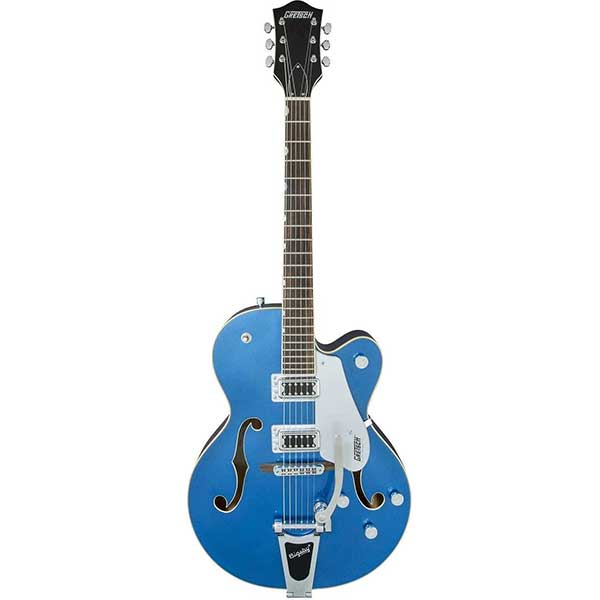
| Estimated Price | $850 |
| Body | 5-Ply Maple |
| Finish | Gloss |
| Colors | Fairlane Blue, Aspen Green, Orange Stain, Candie Apple Red |
| Neck | Maple (Standard U) |
| Fretboard Radius | 12″ |
| Frets | 22 frets |
| Pickups | Filter’tron |
| Tuners | Vintage-Style Open Back |
| Nut | Graph Tech NuBone (42.86 mm) |
My Review: Although I didn’t talk about Gretsch much in this review, they are one of the original guitar companies along with Gibson and Fender. They started back in 1883, with Friedrich Gretsch trying to make banjos, drums, and tambourines in Brooklyn. After his short passing, his son young Fred Gretsch took over the company, and he listened to what the music market wanted at the time – guitars. Like most other guitar companies of the time, they started by making guitars for jazz guitarists and for country-western performers. Over the years, they had guitarists like Chet Atkins playing their guitars in the 1950s, and George Harrison playing their guitars in the 1960s. Although they did not do very well during the psychedelic and rock period during the 1970s through the 1990s, they were able to maintain their classic Gretsch “twang” tone over many years.
The first thing you’ll notice about this guitar is its cheap price point compared to the quality of the guitar. It’s because these are made in South Korea, and it’s a slight upgrade from their predecessor Streamliner series. They are based on classic 6120 Chet Atkins hollow body, and a fun fact is that the new color Fairlane Blue is based on Ford Fairlane, introduced in 1955 – the same year Chet Atkins Hollow Body was unveiled. So you can see the close correlation to the Chet Atkins model. It features a laminated maple top, back, and sides with chrome parts, silver-backed pickguard, and ribbed plastic pickup surround. The pickups are “Blacktop” humbucker pickups, and these have bright and spanky qualities to them – which are exactly what a Gretsch should sound like. They made these pickups by reverse engineering FilterTron pickups, which work best for Gretsch hollow bodies. Of course, you can’t have a Gretsch Hollowbody without a Bigsby tailpiece, and the G5420T features the B60 tailpiece. Unlike other guitars, these have a Master volume, master tone, neck volume, bridge volume. You can get a lot of tonal variations with a master volume and a separate volume knob, and also has a 3-way toggle pickup switch and the sound post of the guitar improves sustain.
One thing that you’ll need to get used to is the size of the guitar and the neck and the frets. It’s slightly larger than the modern commercial guitars, and there’ll be a learning curve if you’re not used to that. It might come with slightly higher string action than you’re used to, you can either change it or just get used to it. Overall, it’s an amazing instrument for the price, and you’ll get that unmistakable Gretsch sound from this guitar for sure.
16. Jackson Rhoads JS32
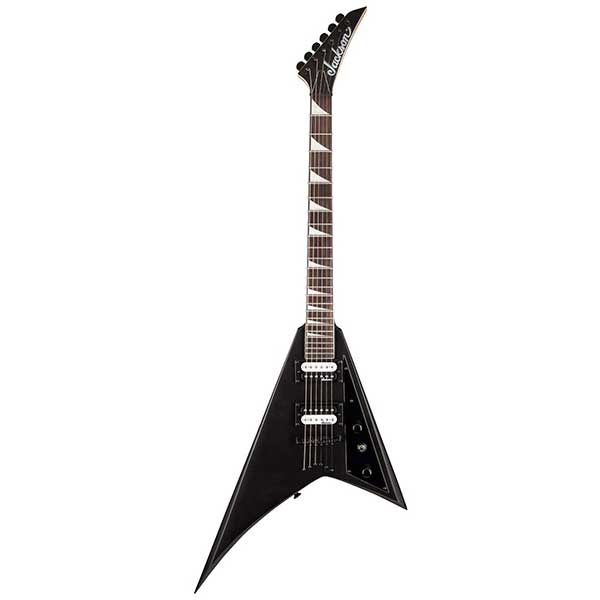
| Estimated Price | $350 |
| Body | Poplar body |
| Finish | Gloss |
| Colors | Black and White Bevels |
| Neck | Maple neck |
| Fretboard Radius | 12″-16″ |
| Frets | 24 frets |
| Pickups | Dual Jackson high output humbuckers |
| Tuners | Sealed die-cast tuners |
| Nut | Floyd Rose Licensed Jackson (42.86 mm) |
My Review: Jackson Guitars are known as the “metal” guitar or the “shred” guitar, and rightfully so. You’ve seen them from Kirk Hammett of Metallica, or Mick Thomson from Slipknot. If you’re listening to a metal guitarist, there’s a high chance that they’re shredding on a Jackson. Jackson Guitars was started back in the late 1970s, from a small guitar repair shop in Southern California. Heavy rock music was on the rise, and this new age of shredding guitarists needed some proper shredding machines. Soon, the Jackson headstock started to appear in the late ‘70s and early ‘80s in MTV, and many hardcore rock and metal guitarists started to play a Jackson. In the late ’80s, a young guitarist named Randy Rhoades contacted Jackson Guitars. He had just joined Ozzy Osbourne’s band and needed a distinctive shredding guitar. Randy and Jackson designers met up just before Christmas and designed their new guitar by sketching it on a paper napkin. The shape was an offset V-shape and a neck through body guitar. At first, the very initial prototype was too similar to the original Gibson Flying V guitar. So they made the top horn of the guitar longer, like a shark’s fin. Even though Randy Rhoads tragically died in March 1982, the classic Rhoads guitar lived on to become known as the Jackson Rhoads. Jackson Guitars are almost synonymous with metal music at this point, used in all things metal – mutation-thrash metal, speed metal, death metal, the NWOBHM, goth industrial, nu-metal, skate metal, grunge, metalcore, rap metal, and more. Recent artists who have their signature Jackson guitar model include Chris Broderick, David Ellefson, Phil Collen, Phil Demmel, and Adrian Smith. In terms of the Jackson Rhoads, Kiss guitarist Vinnie Vincent and Metallica’s Kirk Hammett made the guitar very famous and made it into a cultural sensation.
In the 2000s, Children of Bodom’s lead guitarist Alexi Laiho revived Jackson Rhoads’ popularity and the JS32 still remains an influential guitar in 2020. The JS32 is made with lightweight Poplar wood and is available in Ivory or Satin Grey. JS32 has a sleek bolt-on maple neck, and this allows for faster shredding, or playing chords more comfortably. The fretboard is made up of rosewood, and there are 24 frets, which is essential for maximum shredding! The pickups are two high output humbucking pickups with ceramic magnets, and JS32 has a single volume and tone control. There’s also a three-way toggle switch for pickup selection and has Jackson’s signature double-locking tremolo. You might run into very minor issues like fret buzz and things like that, but considering the $350 price point, it’s a really good quality guitar. Another thing to note is you probably shouldn’t expect the best quality clean tones from this guitar, as it is a strict distortion shredding guitar. But what you could do is run it through lots of chorus and different effects on a clean tone, then you can probably pull off a decent sounding metal clean sound. You might also want to consider the practicing aspect of this guitar. Because it’s a V shape, it’s going to be inevitable that it’s uncomfortable to sit with. But you can’t deny that this beauty looks super badass on stage!
17. Squier Bullet Stratocaster
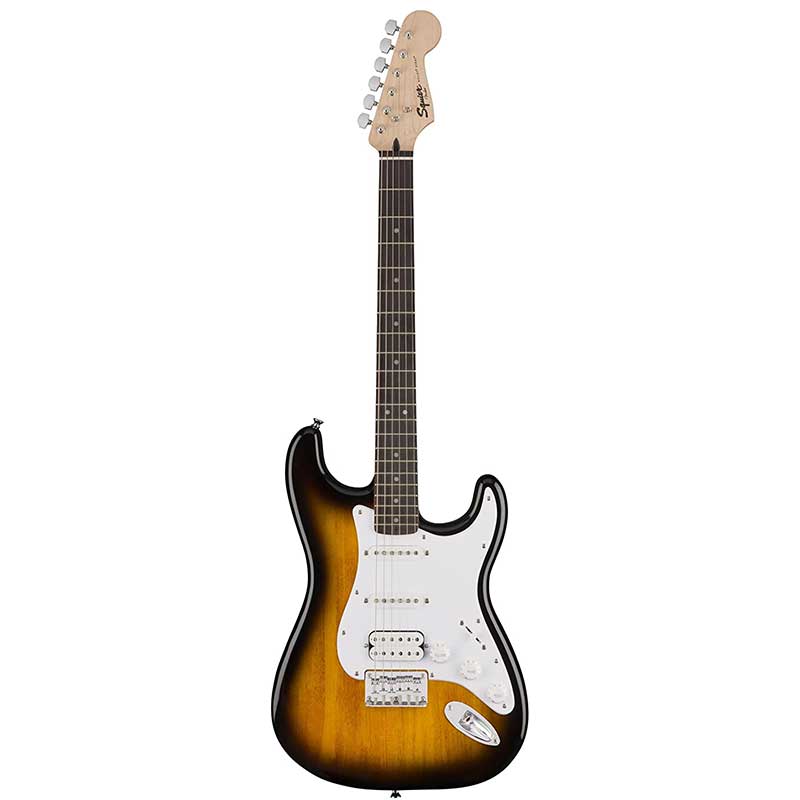
| Estimated Price | $180 |
| Body | Basswood |
| Finish | Brown Sunburst / Polyurethane |
| Colors | Vintage Sunburst, Black, Fiesta Red, Pink, or Arctic White |
| Neck | Maple neck (C shaped neck profile) |
| Fretboard Radius | 9.5″ |
| Frets | 21 frets |
| Pickups | 3 Single-Coil Strat Pickups |
| Tuners | Covered Tuners |
| Nut | 1.650″ (42 mm) |
My Review: Before I end the review, I want to introduce the ultimate complete beginner guitar. The Squier Bullet Strat is the cheapest Strat you’ll find anywhere that is made by Fender and looking at the price just under $200, you’d wonder if the guitar can work at all in the first place. But the surprising thing is that the guitar actually works, and you can really learn to play the guitar and practice with this guitar. Overall, I would characterize this guitar as a “super cheap guitar that doesn’t completely suck”.
The body is made up of basswood, and it has the classic C shaped neck profile. Having a C-shaped neck profile might be a great idea for beginners because you can get used to how a C-shaped neck feels early on, and the transition to the more expensive guitars will be flawless in the future. The guitar also has a working hardtail bridge, and this helps the guitar stay in tune, especially after bending and doing big vibratos. The tuners are actually quite decent, and Bullet Strats feature standard die-cast tuners, and the tuning stays surprisingly stable.
The frets might be a little lacking because this guitar only has 21 frets. But for $180? I’m definitely not gonna complain. One downside of this guitar might be the pickups. These things are loaded with Squier standard single coil pickups, and these are not very good at noise canceling. They are very sensitive, so you might hear some hums and noises when you are plugged into an amp. But in terms of tone, it has a pretty decent tone, and you can even crank some distortion with this guitar. Other than that, Bullet Strats have one volume knob, two tone knobs, and five position pickup selector.
Key Specs and Features:
- Fender Stratocaster at a shocking price
- Basswood body and maple neck
- aC shaped neck profile
- 21 medium jumbo frets
- Hardtail bridge with standard die-cast tuners
- 3 Standard Strat Single Coil
- One master volume, two tone knobs, and five position pickup selector
Choosing the Right Electric Guitar (Buying Guide)
This section is for those of you who want to learn more about electric guitars before reading reviews.
Hollow Body and Semi Hollow Electric Guitars
Hollow body guitars are some of the earliest electric guitars that have been produced commercially. The first hollow body electric guitar was the Gibson ES-150 introduced in 1936. The original purpose of this guitar was to simply have a guitar loud enough to play with a jazz big band. The Gibson ES-150 has an iconic pickup named after a guitar legend, called the Charlie Christian pickup. These were heavy pickups, but the quality of this pickup was way ahead of its time. The Charlie Christian pickups are still regarded as one of the best pickups around, and it provides a deep and rich tone in the neck position of the guitar.
Inspired by violins, the f-hole on a hollow body electric guitar was a huge innovation. The main problem with attaching pickups to acoustic guitars was the feedback noise that came with the large sound hole, and f-holes solved that problem perfectly. After that, there were many new models of hollow body guitars that were produced after World War II. Some had a single cutaway body shape, like the Gibson ES-5 Switchmaster that was introduced in 1949. Other companies like Epiphone, D’aquisto, Ibanez, Gretsch, Eastman started producing high-quality hollow body electric guitars.
In the late 1950s, thinner versions of the hollow body guitars emerged onto the scene. Models like the ES-335, ES-345, and ES-355 were all introduced from Gibson, and they were revolutionary inventions that changed the perception of hollow body guitars. Previously, the hollow body guitars were mostly used in jazz music, but now the semi hollow body guitars were used by rock and roll and blues guitarists as well. Chuck Berry famously used his Gibson ES-335 on his hit song “Johnny B. Goode” in 1958, and the guitar legend BB King also frequently played his Gibson ES-335. Soon after that, the next generation of guitarists such as Eric Clapton, Larry Carlton, Noel Gallagher all played the ES-335. Nowadays, the hollow body and semi hollow body guitars are used in almost all genres of music, and it’s an essential part of electric guitar history.
Solid Body Guitars
Solid body guitars are by far the most popular type of electric guitar, and it’s the guitar that most people think of when you hear “electric guitar”. It’s made with a solid block of wood and doesn’t have air spaces where notes can resonate and amplify. The first solid body electric guitar invented by Les Paul was called the “log” guitar because it had a log-like shape. Not worrying about perfecting the sound hole of the guitar, it gave the inventors more freedom to experiment with all sorts of guitar shapes.
But the real revolution of the solid body electric guitar happened with the invention of the “Merle Travis Bigsby Electric Guitar” in 1947. It was the first electric guitar that actually looked similar to the modern electric guitar, with all six tuners on one side of the headstock and the shape of the body looked like many of the modern electric guitars today. Many believe Paul Bigsby created the first solid body electric guitar, and it was created at the request of the guitar legend Merle Travis. Then in the 1950s, Fender released their now famous Telecaster (originally called the Broadcaster), Gibson released the Gibson Les Paul, followed by the release of Fender’s Stratocaster. Soon came the explosion of Rock and Roll, and the rest is history. The invention and modification of the solid body electric guitars never stopped, with the invention of Eddie Van Halen’s “Frankenstrat” in 1978 to Randy Rhoads‘s “Jackson Flying V” Guitar produced by Jackson Guitars in 1982. Even 7 string and 8 string solid body guitars were produced, and now there are even headless solid body guitars made by companies like Strandberg and Klein.
But even after all these years, the three original solid body guitars – Telecaster, Les Paul, and Stratocaster remain as the most popular type of electric guitars today. Fender and Gibson continue to create reissues and new models that are modifications of one of these three models.
Wrap Up
Every single one of the guitars listed above is selected after a lot of consideration, and these were the top 13 guitars that I think are the absolute best under $1000. I’ve also covered all the different prices under $1000 – from guitars that are just under $1000 to the cheapest beginner guitars that are closer to $100. Most of these guitars above can compete side by side with the top-of-the-line guitars, and can even be used for professional guitarists, with the exception of cheap guitars such as Jackson Rhoads JS32 and Squier Bullet Stratocaster.
All of these guitars have slightly different purposes. Guitars like the Fender Player Stratocaster, Vintera Telecaster, Epiphone Les Paul & SG, Epiphone Sheraton, D’angelico Bedford, PRS SE Custom 24 – these guitars would be a more versatile choice if you were not a big metal or hard rock guitar player. They are all perfect for genres starting from pop, country, blues, jazz to classic rock, and punk rock. You can even play hardcore rock with those guitars as well, but they probably won’t work as well for metal as some of the other choices. Other guitars like Ibanez RG550, ESP LTD EC-1000, Sterling by Music Man Majesty, and Jackson Rhoads are perfect guitars for hard rock and metal, and those guitars would work perfectly with hard distortion and overdrive. Gretsch G5420T is a guitar mainly for country, acoustic, and jazz genres, and the Squier Bullet Stratocaster is the perfect guitar for beginners. At the end of the day, the deciding factor should really be about how you feel about that specific instrument, and not what the price tag looks like. Anyway, whatever guitar you decide to buy, I hope that you can meet your “Lucille”!

My name is Chris and I’ve had a passion for music and guitars for as long as I can remember. I started this website with some of my friends who are musicians, music teachers, gear heads, and music enthusiasts so we could provide high-quality guitar and music-related content.
I’ve been playing guitar since I was 13 years old and am an avid collector. Amps, pedals, guitars, bass, drums, microphones, studio, and recording gear, I love it all.
I was born and raised in Western Pennsylvania. My background is in Electrical Engineering, earning a Bachelor’s degree from Youngstown State University. With my engineering experience, I’ve developed as a designer of guitar amplifiers and effects. A true passion of mine, I’ve designed, built, and repaired a wide range of guitar amps and electronics. Here at the Guitar Lobby, our aim is to share our passion for Music and gear with the rest of the music community.
